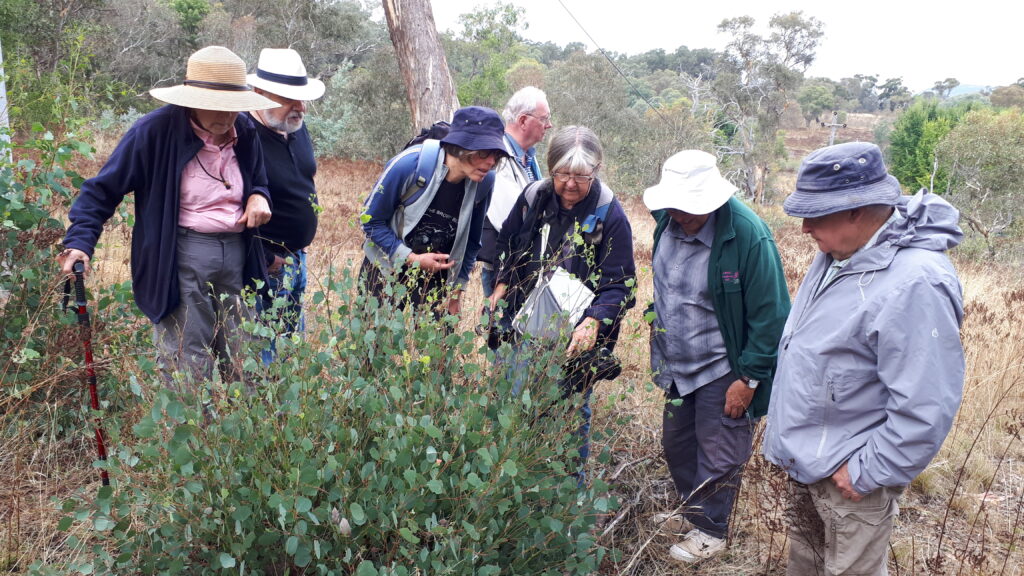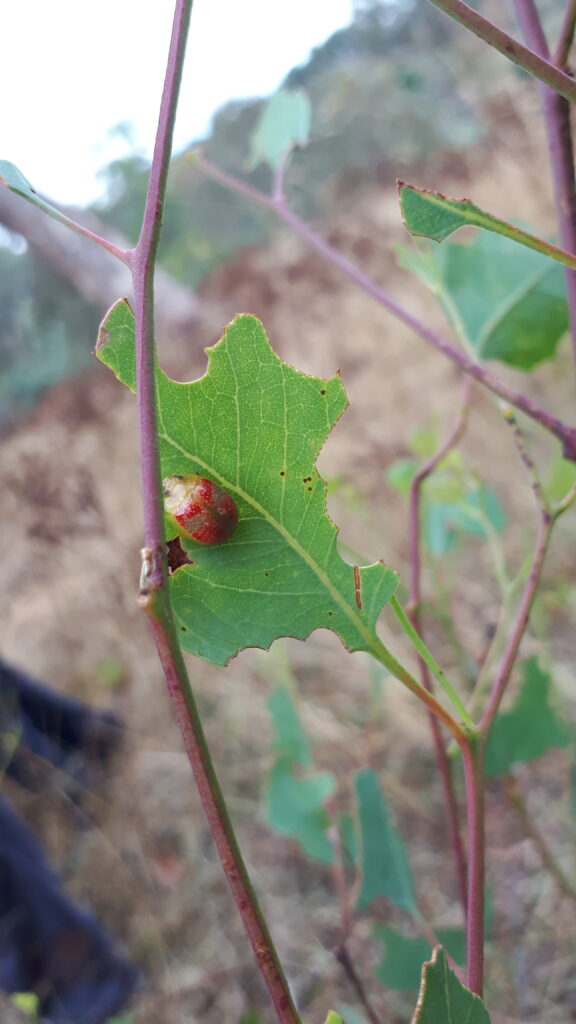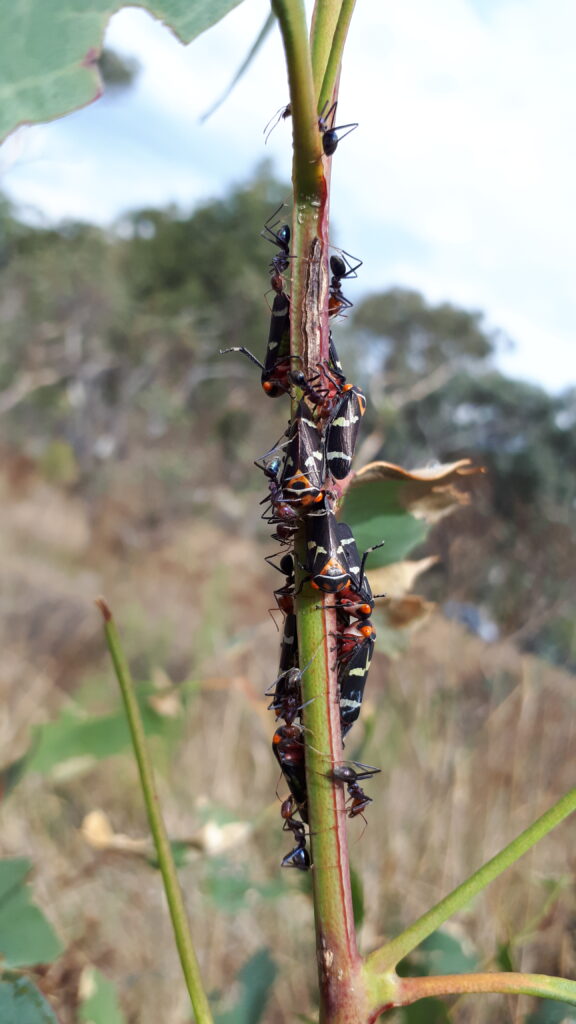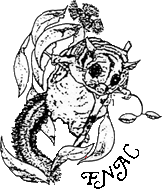On 22 March Alison Milton led about 10 Field Natters on a walk to explore the southern slope of Red Hill in search of fauna.
Even before we set off there were several bird species either seen or heard. A lovely flock of Yellow-tailed Black Cocktaoos flew across but I didn’t manage a photo because of the trees. I thought there was a small flock of Little Corellas but on checking a photo of one atop the mobile phone tower at home, I realised it was the rarer Long-billed Corella.
Jacky had lived in the area until very recently and was eager to show us the Coconut Ants. Some members were not aware of the significance of these ants. They have a symbiotic relationship with the Small Ant Blue Butterfly. They take the eggs into their nest, then tend the larvae until the butterfly emerges. The real significance, however, is that the ACT is the only place in the world where this butterfly can be found.
Around 30 years ago there was a colony under study in Victoria but they disappeared and it was only five years ago that Christine photographed one in the ACT, making it the first sighting in many years. We now know of several breeding locations but the locations are not generally shared to protect the species.
Lifting a sheet of discarded wood revealed a large Banded Sugar ant nest and a slug, then we headed up the slope to find the coconut ants.
We spent a bit of time on the slope moving slowly and not making much ground but there were heaps to be found. Everyone got into the spirit of the exercise and called out when the found something of interest. I think it was Morgan who found the beautiful bag case moth on the same dead tree trunk as the coconut ants.
Other sightings were tiny leaf-rolling weevils, several species of leaf beetles and leafhoppers.
The Scopula rubraria (Plantain moth) was in abundance rising up from the grass as we walked through and the Common Brown butterfly was also, well common.
I didn’t take photos of every sighting but have put most of my photos on Canberra Nature Map (I’m still working on the rest), for identification, especially for those I didn’t know.The sightings can be viewed at https://canberra. naturemapr.org/collections/sightings/9907
The collection is public and other members can add their own photos if they like.
In the two hours we didn’t cover much area but we found a staggering 65 species.
– Alison Milton



Species List
Ants (7)
Black house ant (possibly)
Camponotus consobrinus – Banded Sugar Ant
Camponotus suffusus – Golden-tailed Sugar Ant
Iridomyrmex purpureus – Meat Ant
Notoncus capitatus – An epaulet ant (possibly) tending scale
Papyrius nitidus – Coconut Ant
Rhytidoponera metallica – Greenhead Ant
Arthopods (3)
Beautiful Badge Spider – skin
Phonognatha graeffei – Leaf Curling Spider
Ambigolimax nyctelia – Slug
Beetles (10)
Chrysolina quadrigemina – Greater St Johns Wort beetle
Euops sp. (genus) – A leaf-rolling weevil
Gonipterus scutellatus – gum tree weevil
Paropsisterna cloelia – eggs and larvae
Paropsisterna decolorata
Paropsisterna fastidiosa
Paropsisterna octosignata
Parposis atomaria & eggs Trachymela sp. (genus) – Brown button beetle Transverse lady beetle
Birds (15)
Australian Magpie
Black-faced Cuckoo Shrike
Crimson Rosella
Gang Gang
Grey Butcherbird
Grey Fantail
Long-billed Corella
Noisy Miner
Rainbow Lorikeet
Red Wattlebird
Satin Bowerbird
Spotted Pardalote
Sulphur-crested Cockatoo
Welcome Swallow
Yellow-tailed Black Cockatoo
Butterflies – moths (6)
Cebysa leucotelus – Australian Bagmoth
Heteronympha merope – Common Brown
Pieris rapae – Cabbage white
Platyptilia celidotus – Plume Moth
Scopula rubraria – Plantain Moth
Zizina otis – Common Grass-Blue
Leaf hoppers (5)
Eurymeloides pulchra – Gumtree hopper
Anzora unicolor – Grey Planthopper
Brunotartessus fulvus – Yellow-headed Leafhopper
Chaetophyes compacta – Tube spittlebug (pupae casing)
Ipoella sp. (genus) – Leafhopper (attended by meat ants)
Mammals (2)
European Rabbit
Grey Kangaroo
Other flying insects (9)
Apis mellifera – European honey bee
Black wasp
Braconidae sp. (family) Unidentified braconid wasp
Damsel fly
Echthromorpha intricatoria – Cream-spotted
Ichneumon
Hover fly
Parasitic wasp egg
Praying mantis egg
Sheep blow fly
Other (8)
Amorbus alternatus – Eucalyptus Tip Bug Anisolabididae (family) – Unidentified wingless earwig Aphididae (family) – aphid
Creiis costatus – Shell lerp
Frog (heard)
Johnrehnia concisa- a native cockroach
Scale
Wasp galls
